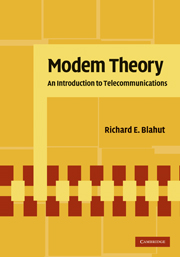Book contents
- Frontmatter
- Contents
- Preface
- Dedication
- 1 Introduction
- 2 Baseband Modulation
- 3 Baseband Demodulation
- 4 Sequences at Baseband
- 5 Passband Modulation
- 6 Passband Demodulation
- 7 Principles of Optimal Demodulation
- 8 Synchronization
- 9 Codes for Digital Modulation
- 10 Codes for Data Transmission
- 11 Performance of Practical Demodulators
- 12 Secure Communications
- Bibliography
- Index
7 - Principles of Optimal Demodulation
Published online by Cambridge University Press: 05 June 2012
- Frontmatter
- Contents
- Preface
- Dedication
- 1 Introduction
- 2 Baseband Modulation
- 3 Baseband Demodulation
- 4 Sequences at Baseband
- 5 Passband Modulation
- 6 Passband Demodulation
- 7 Principles of Optimal Demodulation
- 8 Synchronization
- 9 Codes for Digital Modulation
- 10 Codes for Data Transmission
- 11 Performance of Practical Demodulators
- 12 Secure Communications
- Bibliography
- Index
Summary
This chapter approaches the theory of modem design starting from well-accepted basic principles of inference. In particular, we will study the maximum-likelihood principle and the maximum-posterior principle. By studying the optimum demodulation of passband sequences, we shall develop an understanding of the maximum-likelihood principle and its application. In Chapter 8, we will also treat the topic of synchronization as applied to both carrier recovery and time recovery by using the maximum-likelihood principle.
It is appropriate at this point to develop demodulation methods based on the likelihood function. The maximum-likelihood principle will enable us to derive optimal methods of demodulating in the presence of intersymbol interdependence and, as a side benefit, to establish the optimality of the demodulators already discussed in Chapter 3.
The maximum-likelihood principle is a general method of inference applying to many problems of decision and estimation besides those of digital communications. The development will proceed as follows. First we will introduce the maximum-likelihood principle as a general method to form a decision under the criterion of minimum probability of decision error when given a finite set of measurements. Then we will approximate the continuous-time waveform v(t) by a finite set of discrete-time samples to which we apply the maximum-likelihood principle. Finally, we will take the limit as the number of samples of v(t) goes to infinity to obtain the maximum-likelihood principle for the waveform measurement v(t).
The likelihood function
We begin with the general decision problem, not necessarily the problem of demodulation, of deciding between M hypotheses when given a measurement.
- Type
- Chapter
- Information
- Modem TheoryAn Introduction to Telecommunications, pp. 218 - 250Publisher: Cambridge University PressPrint publication year: 2009



